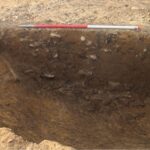Archaeological discoveries in Ravensthorpe have revealed a possible historic small settlement dating back to Roman times, with environmental samples being processed in order to learn the full extent of findings.
For the Transpennine Route Upgrade (TRU) team, groundworks are an essential step in the delivery of upgrades across the route. In certain areas, such work means archaeological fieldwork is necessary in order to identify, understand and safeguard heritage assets that may be affected.
With TRU upgrades being carried out in West Yorkshire, archaeologists from Oxford Archaeology North took to multiple sites on our route in between Huddersfield and Dewsbury.
Excavations at Heaton Lodge and Thornhill Lees Farm produced more commonly found, industrial post-medieval archaeology in the form of earthworks and other minor finds, with no significant remains. It was the works in Ravensthorpe, though, that uncovered some archaeological mysteries.
Following initial work, further investigation of the site was required after the discovery of a large, irregularly shaped cropmark that was thought to be of a prehistoric date.
Last April saw a geophysical survey undertaken, which suggested that this feature was most probably an Iron Age or Romano-British enclosure, with it being hexagonal in shape and including internal penannular features.
An archaeological evaluation identified that the enclosure was fairly substantial in size, and was therefore subject to a strip, map and record towards the end of the year. Despite there being limited artefactual remains; a collection of Romano-British ceramics, ceramic building materials, flint, glass and animal bones were all recovered at the site.
Catherine O’Doherty, Site Supervisor, said: “We have a possible small-scale settlement with round house-like features and boundary ditches which yielded limited finds of a Roman date. This is interesting as sites such as this are limited in West Yorkshire, making this site an exciting discovery.”
Environmental samples collected at the site are now being processed for the recovery of further artefacts and ecofacts – this is seen as a key step in potentially being able to date the evidence and assist in developing the general understanding around the purpose the enclosure once served.
Photo credit: Network Rail



